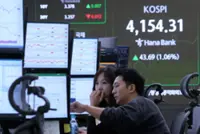A German flag waves in front of the buildings of the banking district in Frankfurt, Germany, Friday, Aug. 30, 2024. (AP Photo/Michael Probst)
BERLIN: Germany’s bonds have stabilised after their worst week since 1990, as investors start to look at whether to buy the debt. The yield on 10-year securities ended last Friday little changed at 2.84%, after hitting the highest since 2023 on Thursday.
With the rate up over 40 basis points – the biggest increase since the aftermath of the Berlin Wall’s fall – some bond strategists are now beginning to turn positive.
“We are in the camp of consolidation and a modest move lower in bond yields,” said Mohit Kumar, chief strategist at Jefferies International, who sees 10-year yields moving back towards 2.75%.
“We would argue that financial expectations are already in the price in rates.”
The slide in Germany’s bunds, traditionally Europe’s safest, sparked a sell-off across global debt markets after the nation announced a historic shift towards more public spending.
While investors have long been clamouring for more issuance of the nation’s triple-A securities, they have started to ask for higher returns to compensate for the expected boost in borrowing in coming years.
While some strategists have been flagging that the German yield could potentially rise a bit further to 3%, a level seen just once since 2011, that could be a signal to buy for investors.
“Markets will likely settle down and re-evaluate,” said Brian Mangwiro, a portfolio manager at Barings.
“Bunds are certainly attractive again at close to 3%.”
Toronto-Dominion Bank thinks the move higher in yields was justified because of the unprecedented change in financial stance, but now recommends a tactical long position on the debt, seeing a range of 2.4% to 2.7% in the coming months.
“We are likely to see more tariff rather than financial news in the coming weeks,” said Pooja Kumra, a TD rates strategist.
“The negative impulse from tariffs will have a more immediate impact than from the longer-term overhaul of the German economy.”
There’s growing scepticism that yields will continue their march higher, given how much uncertainty there is around the European growth and inflation outlook.
European Central Bank officials are bracing for tough negotiations over whether to cut interest rates further or hold fire in April.
Traders also await more clarity on whether the European Union will reform its financial rules to allow member states to spend more, while concern around US trade policy lingers.
“It feels like the short-term move is running out of steam around these sorts of levels,” said Lauren van Biljon, a portfolio manager at Allspring Global Investments, on Bloomberg TV. — Bloomberg





